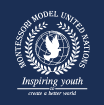Decision Making Stages During Conferences
Debate, Negotiation, and Taking Action are the three stages of Decision Making at the MMUN.
| MMUN Committee (Debate) | The Bureau will open the committee session and introduce the pre-set agenda, speaking time, and speaker’s list. |
| Meeting (Debate) | Delegates deliver a speech explaining their country’s position and solution on their committee’s topic. The order is pre-set alphabetically for the first topic and in reverse order for the second topic. Delegates seeking to reply to a speech or be added to the speaker’s list may send a note to the Bureau. |
| Consultations (Negotiation) | MMUN is now streamlining the negotiation process by more rigorously following the UN’s rules of procedure.
The negotiation phase will now consist of 4 consultations and the line by line review; each will have no time limit and require no motions. The process will move forward automatically as each step is completed. (Voting is no longer necessary since there are no motions.) The flow of the committee proceedings will be as follows:
*formerly known as operative & pre-ambulatory “clauses,” the correct terminology is “paragraph”
A line by line review: Non-sponsors may propose amendments to the draft resolution. Once all amendments have been proposed and collected, the committee will review each amendment to negotiate any objections. |
| Action Phase
(Taking Action) |
The Delegates will then choose a Closing Bureau (3 delegates) to represent the committee and present the draft resolutions at the Closing ceremony.
The Closing Bureau will introduce the final draft resolution(s) with the aim of adoption by consensus. If at least one Member State objects, then the draft resolution is put to a vote. Non-sponsors may have the chance to explain their position or vote before/after action is taken. |
| MMUN Closing (Taking Action) | The resolution(s) are formally adopted by the entire General Assembly. The MMUN Founder will then ceremonially close the session. |
Related Topics
Questions?
If you have questions, please contact us at info@nullmontessori-mun.org
